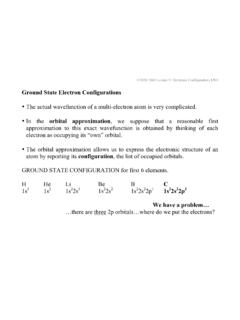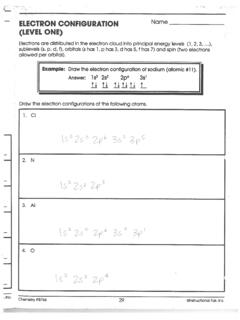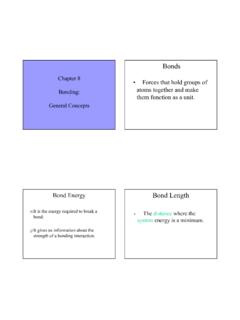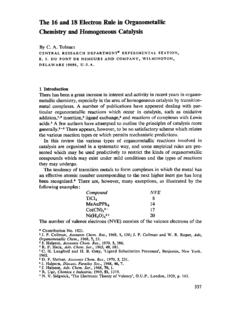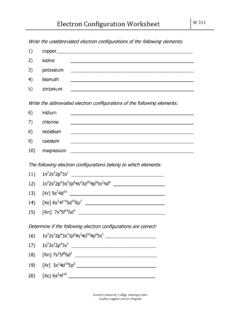Transcription of Solutions Manual for Materials Science and Engineering An ...
1 CHAPTER 2 ATOMIC STRUCTURE AND INTERATOMIC BONDING PROBLEM Solutions Fundamental Concepts Electrons in Atoms Cite the difference between atomic mass and atomic weight. Solution Atomic mass is the mass of an individual atom, whereas atomic weight is the average (weighted) of the atomic masses of an atom's naturally occurring isotopes. Solutions Manual for Materials Science and Engineering An Introduction 9th Edition by CallisterFull Download: all chapters instant download please go to Solutions Manual , Test Bank site: Silicon has three naturally occurring isotopes: of 28Si, with an atomic weight of amu, of 29Si, with an atomic weight of amu, and of 30Si, with an atomic weight of amu.
2 On the basis of these data, confirm that the average atomic weight of Si is amu. Solution The average atomic weight of silicon (ASi) is computed by adding fraction-of-occurrence/atomic weight products for the three isotopes , using Equation (Remember: fraction of occurrence is equal to the percent of occurrence divided by 100.) Thus ASi = f28 SiA28Si + f29 SiA29Si+ f30 SiA30Si = ( )( ) + ( )( ) + ( )( ) = Zinc has five naturally occurring isotopes: of 64Zn with an atomic weight of amu; of 66Zn with an atomic weight of amu; of 67Zn with an atomic weight of amu; of 68Zn with an atomic weight of amu; and of 70Zn with an atomic weight of amu.
3 Calculate the average atomic weight of Zn. Solution The average atomic weight of zinc AZn is computed by adding fraction-of-occurrence atomic weight products for the five isotopes , using Equation (Remember: fraction of occurrence is equal to the percent of occurrence divided by 100.) Thus AZn=f64 ZnA64Zn+f66 ZnA66Zn+ f67 ZnA67Zn+f68 ZnA68Zn+f70 ZnA70Zn Including data provided in the problem statement we solve for AZn as AZn=( )( amu) + ( )( amu) + ( )( amu) + ( )( amu) + ( )( ) = amu Indium has two naturally occurring isotopes: 113In with an atomic weight of amu, and 115In with an atomic weight of amu.
4 If the average atomic weight for In is amu, calculate the fraction-of-occurrences of these two isotopes. Solution The average atomic weight of indium (AIn) is computed by adding fraction-of-occurrence atomic weight products for the two isotopes , using Equation , or AIn=f113 InA113In+f115 InA115In Because there are just two isotopes, the sum of the fracture-of-occurrences will be ; or f113In+f115In= which means that f113In = Substituting into this expression the one noted above for f113In, and incorporating the atomic weight values provided in the problem statement yields amu=f113 InA113In+f115 InA115In amu=( )A113In+f115 InA115In amu=( )( amu)+f115In( amu) amu= amu-f115In( amu)+f115In( amu) Solving this expression for f115In yields f115In= Furthermore, because f113In = then f113In = (a) How many grams are there in one amu of a material?
5 (b) Mole, in the context of this book, is taken in units of gram-mole. On this basis, how many atoms are there in a pound-mole of a substance? Solution (a) In order to determine the number of grams in one amu of material, appropriate manipulation of the amu/atom, g/mol, and atom/mol relationships is all that is necessary, as #g/amu = 1 1023 atoms 1 g/mol1 amu/atom = 10 24 g/amu (b) Since there are g/lbm, 1 lb-mol = ( g/lbm)( 1023 atoms/g-mol) = 1026 atoms/lb-mol (a) Cite two important quantum-mechanical concepts associated with the Bohr model of the atom. (b) Cite two important additional refinements that resulted from the wave-mechanical atomic model.
6 Solution (a) Two important quantum-mechanical concepts associated with the Bohr model of the atom are (1) that electrons are particles moving in discrete orbitals, and (2) electron energy is quantized into shells. (b) Two important refinements resulting from the wave-mechanical atomic model are (1) that electron position is described in terms of a probability distribution, and (2) electron energy is quantized into both shells and subshells--each electron is characterized by four quantum numbers. Relative to electrons and electron states, what does each of the four quantum numbers specify? Solution The n quantum number designates the electron shell.
7 The l quantum number designates the electron subshell. The ml quantum number designates the number of electron states in each electron subshell. The ms quantum number designates the spin moment on each electron . Allowed values for the quantum numbers of electrons are as follows: n = 1, 2, 3, .. l = 0, 1, 2, 3, .. , n 1 ml = 0, 1, 2, 3, .. , l ms = 12 The relationships between n and the shell designations are noted in Table Relative to the subshells, l = 0 corresponds to an s subshell l = 1 corresponds to a p subshell l = 2 corresponds to a d subshell l = 3 corresponds to an f subshell For the K shell, the four quantum numbers for each of the two electrons in the 1s state, in the order of nlmlms, are 100(12) and 100 (-12).
8 Write the four quantum numbers for all of the electrons in the L and M shells, and note which correspond to the s, p, and d subshells. Answer For the L state, n = 2, and eight electron states are possible. Possible l values are 0 and 1, while possible ml values are 0 and 1; and possible ms values are 12. Therefore, for the s states, the quantum numbers are 200(12) and 200(-12). For the p states, the quantum numbers are 210(12), 210(-12), 211(12), 211(-12), 21(-1)(12), and 21(-1)(-12). For the M state, n = 3, and 18 states are possible. Possible l values are 0, 1, and 2; possible ml values are 0, 1, and 2; and possible ms values are 12.
9 Therefore, for the s states, the quantum numbers are 300(12), 300(-12), for the p states they are 310(12), 310(-12), 311(12), 311(-12), 31(-1)(12), and 31(-1)(-12); for the d states they are 320(12), 320(-12), 321(12), 321(-12), 32(-1)(12), 32(-1)(-12), 322(12), 322(-12), 32(-2)(12), and 32(-2)(-12). Give the electron configurations for the following ions: P5+, P3 , Sn4+, Se2 , I , and Ni2+. Solution The electron configurations for the ions are determined using Table (and Figure ). P5+: From Table , the electron configuration for an atom of phosphorus is 1s22s22p63s23p3. In order to become an ion with a plus five charge, it must lose five electrons in this case the three 3p and the two 3s.
10 Thus, the electron configuration for a P5+ ion is 1s22s22p6. P3 : From Table , the electron configuration for an atom of phosphorus is 1s22s22p63s23p3. In order to become an ion with a minus three charge, it must acquire three electrons in this case another three 3p. Thus, the electron configuration for a P3 ion is 1s22s22p63s23p6. Sn4+: From the periodic table, Figure , the atomic number for tin is 50, which means that it has fifty electrons and an electron configuration of 1s22s22p63s23p63d104s24p64d105s25p2. In order to become an ion with a plus four charge, it must lose four electrons in this case the two 4s and two 5p. Thus, the electron configuration for an Sn4+ ion is 1s22s22p63s23p63d104s24p64d10.
